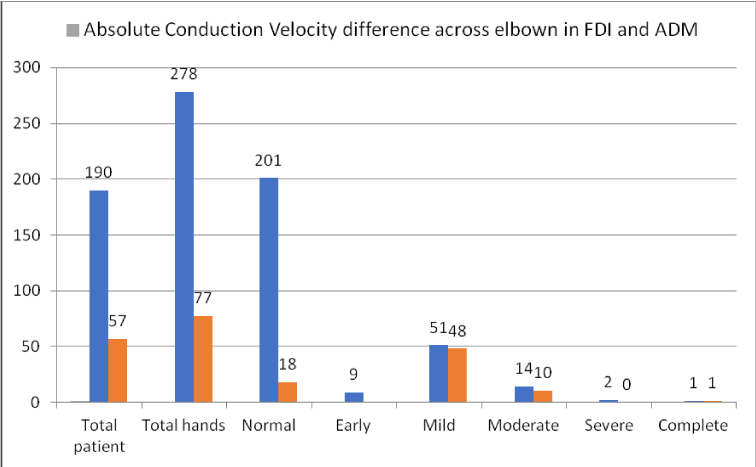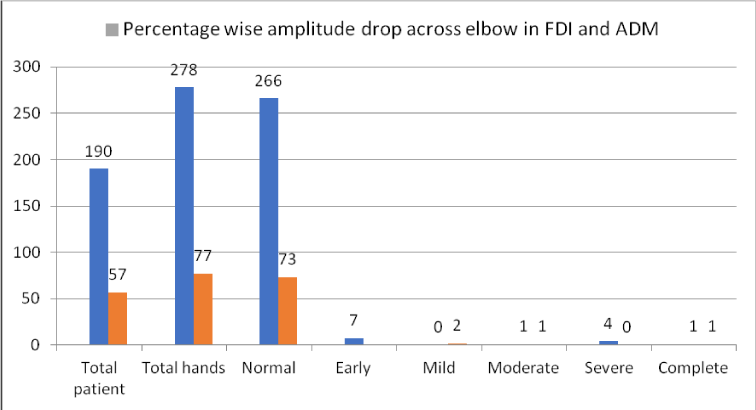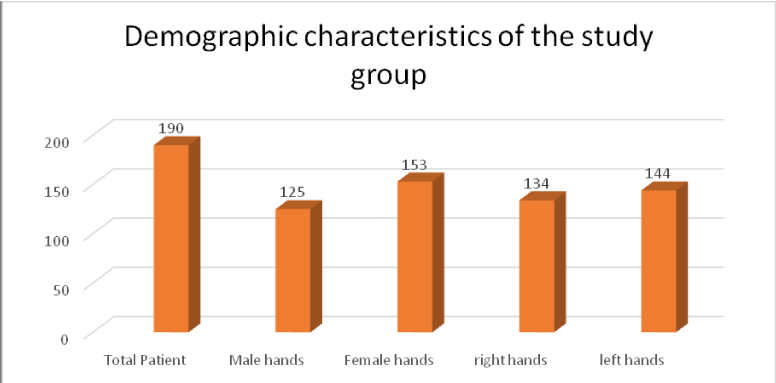Journal of Neurology, Neurological Science and Disorders
Neurophysiological grading tool of ulnar nerve entrapment across the elbow
Salim Hirani*
Cite this as
Hirani S (2023) Neurophysiological grading tool of ulnar nerve entrapment across the elbow. J Neurol Neurol Sci Disord 9(1): 009-013. DOI: 10.17352/jnnsd.000051Copyright
© 2023 Hirani S. This is an open-access article distributed under the terms of the Creative Commons Attribution License, which permits unrestricted use, distribution, and reproduction in any medium, provided the original author and source are credited.Ulnar nerve entrapment across the elbow (UNEAE) is the second most common entrapment of the hand after carpal tunnel syndrome. There are few grades available for UNEAE with their limitations.
The aim of this research is to establish, using the best available evidence, a clinically appropriate revision of the current ulnar nerve conduction grading tool and to evaluate its effectiveness in terms of acceptability, without any invasive tests. To compare the recording from the first dorsal interosseous (FDI) muscles with the abductor digiti minimi (ADM) muscle to see which muscle is more sensitive and shows early changes in ulnar nerve entrapment. The revised scale is designed from a clinical physiologist’s perspective and is based on the numerical values of nerve conduction findings. It could also assist surgeons to use this as a tool for interventional prediction.
The proposed revised grading system is based on more nuanced, descriptive categories, ranging from “normal, “early, “mild, “moderate, “severe,” and “complete” absence. An additional category of clinical grading is therefore proposed.
Method: Data was collected based on the extensive and detailed grading system previously described by Padua. The tests were performed by a qualified clinical physiologist (neurophysiology) using a Keypoint 9033A07 machine, used in line with the departmental protocol (peripheral protocol 1, 2015). The Association of Neurophysiological Scientists (ANS) and British Society of Clinical Neurophysiology (BSCN) (2014) guidelines and minimum standards for the practice of clinical neurophysiology in the United Kingdom were followed. All data was recorded numerically to ensure methodological reliability.
Result: The data was collected over the course of one year (2017). A total of 190 patients were involved in this study. A collection of 278 consecutive symptomatic hands was tested for conduction block across the elbow while recording from the first dorsal interosseous FDI muscles. Out of the 278 samples, 201 hands were graded as having normal conduction velocity: 9 hands showed early changes, 51 hands showed mild changes, 14 hands showed moderate changes, 2 hands showed severe changes, and 1 hand showed complete absence or no response from the wrist and across the elbow.
Additional studies were carried out from the abductor digiti minimi (ADM) muscles for those patients who showed conduction block across the elbow while recording from the FDI muscles. Only 57 patients underwent a nerve conduction study for ADM. 77 symptomatic hands were tested for conduction block in the ADM muscle. 18 hands were graded as normal; 48 hands showed mild changes; 10 hands showed moderate changes; and 1 hand showed complete absence or no response from the wrist and across the elbow.
Out of 278 hands, 266 hands were graded as having normal amplitude across the elbow while recording from FDI muscles; 7 hands showed early changes in amplitude; 1 hand showed moderate amplitude change; 4 hands showed severe amplitude changes; and 1 hand showed complete absence or no response from the wrist and across the elbow.
Out of 77 hands, 73 hands showed normal amplitude across the elbow while recording from ADM muscles; 2 hands showed mild changes; 1 hand showed a moderate change; and 1 hand showed complete absence or no response from the wrist and across the elbow.
Conclusion: Finding show that FDI is more sensitive in comparison to ADM to record early changes in ulnar nerve entrapment across the elbow. In addition, it shows that a drop in amplitude is not as significant when compared to a conduction block across the elbow.
Background
Ulnar nerve entrapment across the elbow (UNEAE) is the second most common entrapment of the hand after carpal tunnel syndrome [1]. There are only a few UNEAE gradings available, each with its own set of limitations. The cubital tunnel is the most common site for entrapment around the elbow [2]. The most important signs of ulnar neuropathy at the elbow are numbness of the 4th and 5th digits, hypoesthesia of the medial palm, atrophy, and paraesthesia of ulnar nerve innervated hand muscles, and sometimes flexion deformity of the fingers due to motor dysfunction of the flexor carpi ulnaris muscle [3]. Motor nerve conduction studies (NCSs) are considered to be more sensitive when recorded from FDI than from ADM [2].
Reason for grading of the ulnar nerve
The grading tool is used for the diagnostic assessment of the ulnar in conjunction with the patient’s clinical history and symptoms [4] in order to diagnose the level of UNEAE [4]. The revised grading tool using a physiological basis offers more precise numerical grading, that is both objective and repeatable. This would not only help the clinical physiologist to grade their results according to the proposed grading scale but also support the surgeon to ascertain the level of severity in order to decide on either a conservative or surgical approach to treatment.
Padua [5] grading in 2001 differentiated the level of entrapment of ulnar nerves across the elbow by recording from the ADM muscles with a small amount of data. He made five grades, i.e., normal, mild, moderate, severe, and very severe. Dellon [6] differentiated the level of entrapment of the ulnar nerve based on observations. Alessandro [7] in 2009 followed the Padua [5] grading system and created a grading of ulnar nerve entrapment across the elbow while recording from the FDI and ADM muscles and also conducted an EMG study. Alessandro [7] sample size was small too, and he suggested three gradings, i.e., mild, moderate, and severe. Another researcher investigated ulnar nerves through ultrasound or based on patients’ symptoms. In 2015, Gulistan [2] published his paper with a small sample size, where he created 5 gradings of the ulnar nerve across the elbow, from normal to very severe, with extensive testing of the FDI and ADM muscles. Furthermore, the author included a needle EMG study in his grading. In the UK setting, where the majority of patients with ulnar nerve symptoms are investigated by physiologists who do not have EMG in their skill set and also not recommended by ANS and BSCN guideline till today. It appears that whilst there is an accepted dominance of Padua [5] grading systems, there are also clear limitations, which are described in detail in this paper.
The aim of this research was to establish an evidence-based revision of the current ulnar nerve conduction grading tool and evaluate its effectiveness in terms of acceptability and usability as a tool for intervention prediction.
A numerical value is given to each of the grade bandings to enable objective reporting and comparison [2]. To compare the recordings from the first dorsal interosseous (FDI) muscles and the Abductor Digiti Minimi (ADM) muscle to evaluate which muscle is more sensitive and shows early changes in ulnar nerve entrapment. The revised scale is designed from a clinical physiology perspective and based on the numerical values of nerve conduction findings. However, this could enable the surgeon to ascertain the level of severity in order to decide on either a conservative or surgical approach to treatment (if they wanted to follow the proposed grading). The proposed revised grading system is based on more nuanced, descriptive categories, ranging from normal to early to complete absence.
Methods
Neurophysiological data was collected based on the grading system previously described by Padua [5]. The Association of Neurophysiological Scientists (ANS) and British Society of Clinical Neurophysiology (BSCN) (2014) guidelines and minimum standards for the practice of clinical neurophysiology in the United Kingdom were followed. In addition, a few new grading was introduced in keeping with Padua [5] grading to justify the new grading scale.
Patient and public involvement
The test was performed by a qualified Clinical Physiologist (Neurophysiology) using the Keypoint 9033A07 (Skovlunde, Denmark) machine on the basis of departmental protocol (Peripheral protocol1, 2015). A quantitative method was used to collect the data [1], to ensure accuracy and avoid bias. The sample size of patients in the study was used for all those tested for NCS over a period of one calendar year (2017), across the population of North Wales. No individual patient was recruited in this research.
The inclusion criteria were considered only on the basis of the referral diagnosis. No clinical assessment was conducted in the department prior to the study. The data was collected from patients with an age range above 18 years who were referred to the Neurophysiology department from the Orthopaedics and Neurology departments within the local Health Board, as well as General practitioners (GPs) in North Wales. Referral of Ulnar nerve entrapment, Cubital Tunnel entrapment, Tennis elbow, and Guyon’s Canal entrapment was considered based on paraesthesia, pain, and swelling in the ulnar distribution area or digits IV-V and around the elbow.
Cervical radiculopathy, polyneuropathy, or any other clinical significance other than ulnar nerve entrapment was excluded from this research.
Data was analyzed on sensory amplitude, conduction velocity, motor distal latency, amplitude, and conduction velocity [2]. To introduce the terms “normal”, “early”, “mild”, “moderate”, “severe” and “complete”, a numerical value was used that is widely accepted and to be used to compare with other researchers.
The procedure began by carrying out the sensory setting by placing the stimulating ring electrodes on digit III and recording the electrode at the surface of the median nerve at the wrist. The same procedure for ulnar nerve testing by stimulating the ring electrode placed on digit V and recording was made from the medial part of the ulnar nerve distribution at the wrist. The orthodromic technique was used for the sensory and motor Nerve Conduction Studies (NCS) test, through the median and ulnar nerves. A maximal current was applied to record the response of the nerve at digit III for median sensory recording and digit V for ulnar sensory recording. Stimulating median nerve pathways at the wrist and at the elbow for motor recording from the abductor polices bravis (APB), and ulnar nerve pathways from First dorsal interosious (FDI). Measurement was made across elbows by keeping the elbows at 80-90 degrees for the ulnar nerve [1]. The distance across the elbow was kept constant between 10 and 12 cm1. If the motor response from FDI displayed a conduction velocity (CV) block across the elbow or more than a 20% drop in the amplitude with normal CV and amplitude between the elbow and the axilla, then the response was recorded by stimulating the ADM muscles with the ulnar pathway from the axilla [1]. If the response from FDI displayed low amplitude below the elbow, Martin Gruber’s protocol was followed [1]. If the sensory amplitude in the ulnar nerve digit V displayed low amplitude, a recording was made from the wrist by stimulating the ulnar nerve at the mid palm. If the response displayed low amplitude in the mid palm, a dorsal ulnar cutaneous nerve study was carried out by stimulating the dorsal side of the ulnar cutaneous branch to diagnose Guyon’s Canal entrapment.
All patient data were collected by fulfilling the criteria mentioned in the above paragraph, depending on the severity. The reason for using the above criteria is to describe the full range of severity, which was not fully covered by other researchers mentioned in this paper. The above criteria are intended to be more reliable in terms of grading for Clinical physiologists and probably will provide support to the surgeon in terms of patient treatment decisions.
Data was collected for the wrist lesion in ulnar nerve pathways, or if there are signs of Martin Gruber anastomosis, which were not included in this research.
The grades are as follows
Absolute conduction velocity across the elbow or drop of amplitude across the elbow
Normal: CV> = 50 m/s in FDI and ADM, distal motor latency <= 4.2 ms and amplitude >5mv, and sensory amplitude >5µv and sensory conduction velocity >=50 m/s
Early: CV = 41-49m/s in FDI and Normal in ADM with normal sensory potentials>5µv. Or more than a 20% drop of amplitude in FDI across the elbow and normal in ADM.
Mild: CV = 41-49m/s in both FDI and ADM with normal sensory potentials. Or amplitude drop across the elbow of more than 20% in both FDI and ADM and normal between wrist to elbow and above the elbow to the axilla.
Moderate: CV = 30-39m/s in both FDI and ADM with low sensory potentials from digit V to wrist. Or amplitude drops more than 40% across the elbow in both FDI and ADM.
Severe: CV < 30m/s with absent sensory nerve action potentials.
Complete: Sensory and motor responses are absent. Need further study to localize the lesion.
Result: The data was collected for a period of one year (2017). A total of 190 patients were involved in this study.
Conduction block
278 consecutive symptomatic hands tested for conduction block across the elbow while recording from FDI muscles. 201 hands were graded as having normal conduction velocity; 9 hands showed early changes where FDI shows conduction block across the elbow and normal across the elbow with ADM; 51 hands showed mild changes in both FDI and ADM, 14 hands showed moderate changes in both FDI and ADM; 2 hands showed severe changes in both FDI and ADM and 1 hand showed complete absence or no response from wrist and across elbow in both FDI and ADM muscles.
Additional studies were carried out from ADM muscles for those patients who showed conduction block or drop of amplitude across the elbow while recording from FDI muscles. Only 57 patients underwent a nerve conduction study for ADM. 77 symptomatic hands were tested for conduction block for ADM muscle. 18 hands were graded as normal; 48 hands showed mild changes, 10 hands showed moderate changes and 1 hand showed complete absence or no response from the wrist and across the elbow. (Early changes criteria were used only while recording from FDI muscles). Comparison of absolute conduction velocity block across elbow in ADM and FDI is shown in Table 1 and graph 1.
A drop in amplitude
266 symptomatic hands were graded as normal amplitude across the elbow while recording from FDI muscles; 7 hands showed early changes in amplitude; 1 hand showed moderate amplitude changes; 4 hands showed severe amplitude changes and 1 hand showed complete absence or no response from wrist and across the elbow.
73 symptomatic hands showed normal amplitude across the elbow while recording from ADM muscles; 2 hands showed mild changes, 1 hand showed moderate change and 1 hand showed complete absence or no response from the wrist and across the elbow. A comparison of a drop of amplitude across the elbow in ADM and FDI is shown in Table 2 and Graph 2.
Discussion
Gulistan [2] grading is very similar to the proposed grading. The only difference is that we included an early entrapment of the ulnar nerve from FDI on the basis of a conduction block or a drop of amplitude across the elbow.
Comparing the ADM grading between Padua [5] and the proposed grading, they show similar values in ADM. We cannot compare the proposal grading with Padua [5] in FDI because Padua [5] did not collect the data through the FDI muscles. FDI shows an early sign of ulnar nerve entrapment, which is mentioned in the proposed grading.
Padua [5] grading is the most commonly used grading system by most researchers. However, due to the lack of numerical grading, the Padua [5] grading does not enable the level of severity to be objectively and fully ascertained. Gulistan [2] grading is similar to the proposed grading because he included FDI and ADM in his research. Gulistan [2] did not make any clarification in his research paper, as his grading shows no differences between FDI and ADM. In the revised grading, the early involvement is graded as Grade 2, which differentiates between the involvements of the muscles.
While comparing between conduction block and drop amplitude across the elbow, our data shows that the drop of amplitude across the elbow which was not as prevalent when compared to the conduction block, while recording from both FDI and ADM muscles. In addition, we also noticed that FDI shows an early conduction block across the elbow as compared to the ADM Table 3.
Comparing the gender and hands testing, females are more likely to be affected compared to males, and the left hand is more likely to be affected as compared to the right (Table 4 and Graph 3).
Conclusion
The grading system devised by Padua [5] which was used to grade the levels of severity of ulnar nerve within the UK has certain limitations, similar to the grading by Gulistan [2]. The system needs modification in order to accommodate current practices. The revised grading system for ulnar nerves is based on a review of a broad spectrum of current and past literature. Within the limits of this study, the present investigation demonstrates that the revised grading tool will be comparable with Padua [5] grading in ADM, and by adding FDI to the grading, it will enable the detection of early stages of ulnar nerve entrapment across the elbow.
The revised grading tool using a physiological basis offers a precise numerical grading that is both objective and repeatable. This could not only help the Clinical Physiologist to grade their results according to the proposal grading scale but also support the surgeon in ascertaining the level of severity and helping to decide on either a conservative or surgical approach to treatment. Please note that this research was made to amend the grading for Clinical Physiologist. Although, surgeons have to make their own decisions for the treatment of UNEAE. It would be advisable to begin physiotherapy treatment in the early grades. Conservative treatment or intervention of steroid treatment is appropriate for the mild grade; a surgical approach would be useful for the moderate grade, where the chances of full recovery are higher. A surgeon could decide to go for a surgical intervention for Severe Grades, regardless if it would be beneficial or not, given the patient’s age and another medical history. Further EMG needles examination would be helpful only to diagnose the level of severity in complete block or complex condition of the ulnar nerve.
Written consent from participants
Written consent was obtained from all participants and filed in patient notes and a copy was kept in the department.
Availability of data and materials
The datasets analyzed during the current study are not publicly available as they are held within patient records but are available from the corresponding author on request.
Author’s contribution
The Author contributed through the collection, analysis, and interpretation of data and in writing the manuscript.
The author would like to acknowledge and thank Dr. Gareth Payne and Dr. Bashir Kassam and Salina Hirani for their encouragement, guidance, and help with this study.
- Practice parameter for electrodiagnostic studies in ulnar neuropathy at the elbow: summary statement. American Association of Electrodiagnostic Medicine, American Academy of Neurology, American Academy of Physical Medicine and Rehabilitation. Muscle Nerve. 1999 Mar;22(3):408-11. doi: 10.1002/(sici)1097-4598(199903)22:3<408::aid-mus16>3.0.co;2-7. PMID: 10086904.
- Halac G, Topaloglu P, Demir S, Cıkrıkcıoglu MA, Karadeli HH, Ozcan ME, Asil T. Ulnar nerve entrapment neuropathy at the elbow: relationship between the electrophysiological findings and neuropathic pain. J Phys Ther Sci. 2015 Jul;27(7):2213-6. doi: 10.1589/jpts.27.2213. Epub 2015 Jul 22. PMID: 26311956; PMCID: PMC4540851.
- Gu Y. Current status and suggestion of clinical classification of carpal and cubital tunnel syndromes. Zhongguo Gu Yu Guan Jie Sun Shang Za Zhi. 2011: 3: 818‑819.
- Ehler E, Ridzoň P, Urban P, Mazanec R, Nakládalová M, Procházka B, Matulová H, Latta J, Otruba P. Ulnar nerve at the elbow - normative nerve conduction study. J Brachial Plex Peripher Nerve Inj. 2013 Feb 11;8(1):2. doi: 10.1186/1749-7221-8-2. PMID: 23398737; PMCID: PMC3653784.
- Padua L, Aprile I, Mazza O, Padua R, Pietracci E, Caliandro P, Pauri F, D'Amico P, Tonali P. Neurophysiological classification of ulnar entrapment across the elbow. Neurol Sci. 2001 Feb;22(1):11-6. doi: 10.1007/s100720170030. PMID: 11487184.
- Dellon AL. Review of treatment results for ulnar nerve entrapment at the elbow. J Hand Surg Am. 1989 Jul;14(4):688-700. doi: 10.1016/0363-5023(89)90192-5. PMID: 2666496.
- Volpe A, Rossato G, Bottanelli M, Marchetta A, Caramaschi P, Bambara LM, Bianconi C, Arcaro G, Grassi W. Ultrasound evaluation of ulnar neuropathy at the elbow: correlation with electrophysiological studies. Rheumatology (Oxford). 2009 Sep;48(9):1098-101. doi: 10.1093/rheumatology/kep167. Epub 2009 Jun 30. PMID: 19567661.
- Karatas A, Apaydin N, Uz A, Tubbs R, Loukas M, Gezen F. Regional anatomic structures of the elbow that may potentially compress the ulnar nerve. J Shoulder Elbow Surg. 2009 Jul-Aug;18(4):627-31. doi: 10.1016/j.jse.2009.03.004. Epub 2009 May 29. Erratum in: J Shoulder Elbow Surg. 2010 Apr;19(3):477. Tubbs, Shane R [Tubbs, R Shane]. PMID: 19481960.
Article Alerts
Subscribe to our articles alerts and stay tuned.
 This work is licensed under a Creative Commons Attribution 4.0 International License.
This work is licensed under a Creative Commons Attribution 4.0 International License.





 Save to Mendeley
Save to Mendeley
